A Long Time Coming: Rawhide Unit 1 Is Coal Users’ Group Plant of the Year
Credit to Author: Aaron Larson| Date: Thu, 01 Jun 2023 04:30:00 +0000
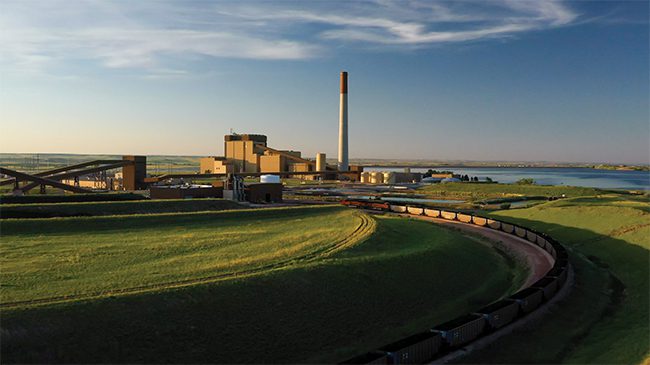

After years of upgrade and retrofit projects, and a keen focus on safety and continuous improvement, the Coal Users’ Group board of directors selected Platte River Power Authority’s Rawhide Unit 1 as the group’s 2023 Plant of the Year.
I’m sure we’ve all experienced disappointments in life. Perhaps some readers have been part of an athletic team that worked hard and progressed all the way to a league championship game, only to lose in the final contest. It can be heartbreaking. But what do true winners do after such a setback? Most get back to work preparing for the next opportunity. And when the time comes, they are more prepared and motivated than ever to capture the prize.
The team at Rawhide Energy Station Unit 1, a 280-MW coal-fired power plant in Larimer County, Colorado, owned and operated by Platte River Power Authority (Platte River), knows what that’s like. The plant was nominated for the Coal Users’ Group (CUG) Plant of the Year award more than a decade ago. The CUG, then known as the Powder River Basin Coal Users’ Group (PRBCUG), sent a team of inspectors to the site to evaluate the plant, and although they thought the plant was exceptional in many ways, they didn’t give Rawhide the award because it had some issues with its coal system.
“At that time, feelings were hurt,” said Andy Cofas, vice chair of the CUG and former plant manager at the Rawhide facility. “But what did they do? They picked themselves up and said, ‘You know what? What do we need to do to become that type of plant? We know we’ve got the safety. We know we’ve got the reliability. Let’s look at what this group said.’ And they went on a multi-year—10-plus-year project—multi-million dollars, in phases, through planned outages, to get to the point where the plant was nominated again, and at this point, won the award,” Cofas explained.
A Showcase Facility
“We aren’t perfect, but a lot of the stuff that made us better came from this conference and listening to the other users,” Travis Hunter, director of Power Generation with Platte River, said during a presentation at the CUG annual meeting in Orlando, Florida, earlier this year. “Give a round of applause for the Coal Users’ Group putting this conference on and making everybody’s plant or facility safer and better.”
Platte River is a not-for-profit, community-owned public power generation and transmission utility that provides energy and services to Estes Park, Fort Collins, Longmont, and Loveland, Colorado, for delivery to their utility customers. Platte River was founded in 1973 and is headquartered in Fort Collins. Besides the Rawhide Energy Station (opening image), Platte River’s equipment includes 27 substations, 263 miles of wholly owned and operated high-voltage lines, and 522 miles of high-voltage lines jointly owned with other utilities. Its record high peak demand was set on July 28, 2021, when its system topped out at 707 MW.
Rawhide Unit 1 was commissioned in the spring of 1984. It has long been a model for efficiency, reliability, and environmental performance. “From its inception, Rawhide has operated as a world-class facility and I’m pleased that it’s being named Plant of the Year,” Jason Frisbie, general manager and CEO of Platte River, said in a statement issued after the CUG award was announced. “This prestigious designation for Rawhide Unit 1 is made possible through the commitment and dedication of all Platte River employees, past and present, who ensure the safe and successful operation of the unit.”
Rawhide Unit 1 has a lifetime capacity factor of 84.31%. In 2019, the unit achieved a record-breaking 436 days of continuous operation, and it often remains online without interruption for 200 days or more. Rawhide Unit 1 was designed to burn low-sulfur coal from the Powder River Basin in Wyoming and it was among the first units in the U.S. to include a spray dryer absorber (SDA) to remove sulfur dioxide (SO2) from gases produced by burning coal. The SDA has helped make Rawhide one of the lowest SO2-emitting coal plants in the country.
The plant operates a tangentially fired boiler designed by Combustion Engineering. It has a Siemens Westinghouse turbine generator and a baghouse to reduce particulate emissions. “It’s kind of unique where we get our water from,” Hunter explained. “We have two different pipelines. One for the service potable-type water that comes from Horsetooth Reservoir that sits just to the west of Fort Collins. So, that’s a 10-inch pipeline that brings water up to the plant. And then our cooling pond is effluent water from the City of Fort Collins. So, that’s brought up from the city in a 24-inch pipeline into our reservoir, and that’s how we cool the steam.”
The coal unit is only one of several sources of generation at Rawhide Energy Station. The site also includes 388 MW of gas turbine capacity in the form of four GE 7EA units and one GE 7FA unit. There is also 52 MW of solar capacity installed on the site, although Platte River doesn’t own the solar arrays but rather purchases the power through agreements. There is also 2 MW of Tesla battery storage capacity on-site. Lastly, there’s a 225-MW wind farm that interconnects through Rawhide’s substation. The wind turbines are located about 10 miles north of the plant in Wyoming.
Tyler Michie, Rawhide Unit 1’s operations manager, who began as an intern and has worked at the station for more than 16 years, explained that safety is a big part of the culture at the plant. “Safety is a core value at Platte River,” he said. “In my time there, we surpassed a million man-hours without a lost time accident three times. We’re currently at about 1.8 million and we’re hoping to keep going. So, safety is certainly something we take to heart.”
The plant also has an enviable heat rate, a measure of efficiency. As most POWER readers know, heat rate is the amount of energy used by a thermal power plant to generate one kilowatt-hour (kWh) of electricity, generally expressed in British thermal units (Btu) per net kWh generated. According to the Energy Information Administration, the average heat rate for U.S. coal power plants in 2021 was 10,583 Btu/kWh. While supercritical and ultrasupercritical units, which have systems that operate at very high temperatures and pressures, are more efficient, Rawhide operates a subcritical boiler—1,800 psi drum-type unit—so operating at less than 10,000 Btu/kWh, as it does during its best months, is impressive.
A Strong History of Upgrades
When Unit 1 was constructed, its nameplate capacity was 250 MW. Retrofits over the years have bumped that up to 280 MW, as mentioned previously. “Quite a bit of that comes from the turbine upgrades,” Michie explained. The unit’s high-pressure/intermediate-pressure (HP/IP) turbine was upgraded in 1998, and again in 2008. The low-pressure (LP) turbine was upgraded in 2005 (Figure 1).
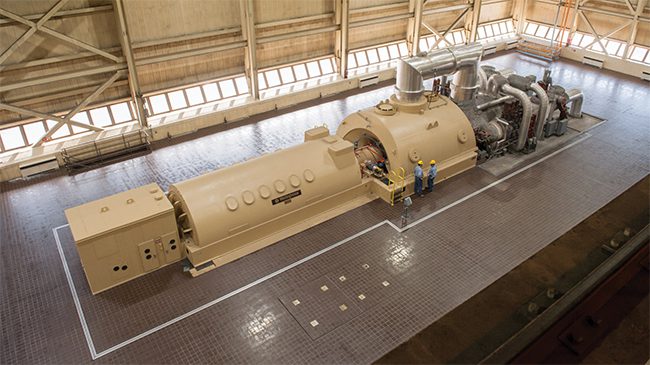 |
1. Rawhide Unit 1’s steam turbines have been upgraded over the years, adding about 30 MW of capacity to the unit. Courtesy: Platte River |
New low-nitrogen oxides (NOx) burners were also installed in 2005. Michie said the change reduced NOx emissions from about 0.3 lb/MMBtu down to about 0.18 lb/MMBtu. The plant did some further refinements to operations in 2012, and got NOx emissions down to about 0.14 lb/MMBtu. Michie said that today the plant runs at about 0.12 lb/MMBtu, which is remarkably good performance for a plant that doesn’t utilize selective catalytic reduction (SCR).
Rawhide Unit 1 installed a mercury removal system in 2008, which came with some growing pains—it didn’t play well with the SDA. “We managed to fight our way through that,” said Michie, and the system operates well today.
The plant’s original distributed control system was installed in 2005, but it was upgraded to the Emerson Ovation platform in 2015. The station also changed the gas turbine units’ control systems to Ovation, which has made life easier for the instrumentation and control (I&C) team. “They don’t have to know three or four different systems anymore—huge investment, but that’s been really valuable,” said Michie.
As previously mentioned, Rawhide Unit 1’s lifetime capacity factor of greater than 84% is incredibly high, but as more renewable resources have been added to Platte River’s system, needs from the unit have evolved. Now, flexibility has become extremely important, which means having wide turndown capability is crucial to staying online. “So, on a 280-MW unit, we’re regularly turning it down to 80—that’s kind of our ‘happy place’ with two mills, things are stable,” Michie said. “We’ve done some tests down to 55 with a single-coal-mill configuration. Fortunately, dispatch isn’t asking for that very often, but proof of concept, we can do it, if we have to.”
Among the more recent projects, Rawhide replaced its wet coal ash system and closed impoundments in 2020 to meet coal combustion residual (CCR) requirements. The following year, it removed boiler feed pump and induced draft (ID) fan fluid drives, and installed variable frequency drives on the motors instead. “That was enormous. We’ve got better control and saved almost four megawatts in house load,” said Michie. Of course, it came with its own trials, such as figuring out how to balance a 12-foot extension shaft between a 5,000-hp motor and a fan, but Michie called it “a really good project.”
Coal Handling Improvements
Yet, the area that CUG identified as lacking in Rawhide’s original Plant of the Year nomination was its coal system, so that’s where the real improvements needed to be made. The station started by adding a new rotary car dumper (RCD) dust collector (Figure 2). “That probably had the single-biggest impact,” said Michie.
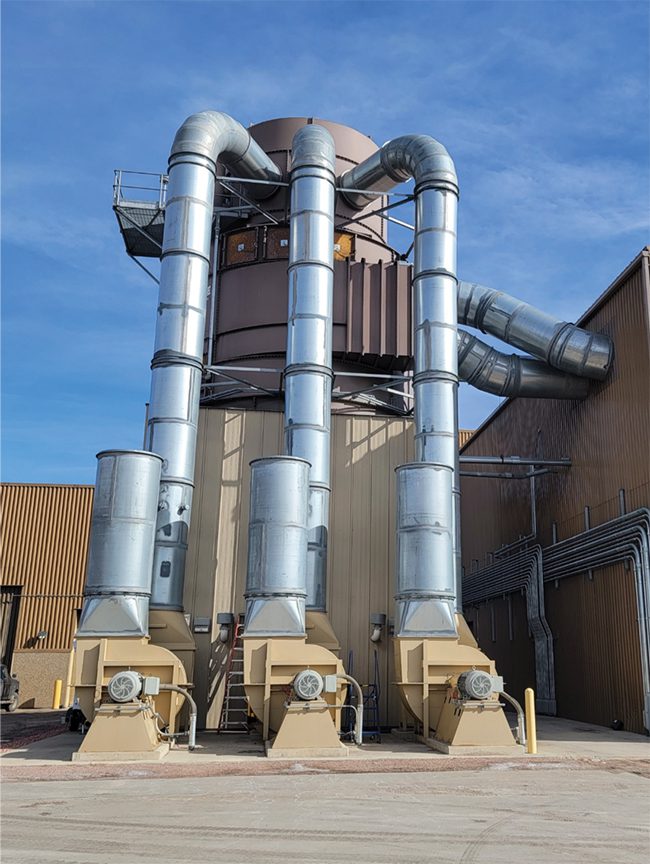 |
2. The rotary car dumper dust collector helped cut down on the amount of dust that needs to be cleaned up after receiving coal. Courtesy: Platte River |
Before the upgrade, after every third 80-car unit train was dumped, workers would have to clean up dust that was more than a foot thick at the bottom of the Grizzly, which is a feeder that helps with proper sizing of the coal. Workers had considered that a “cost of doing business,” in other words, somewhat inevitable. Upgrading to the new dust collector system made a huge difference, and it came with a new way to handle the dust after collection
Previously, the dust was simply dumped back on the conveyor belt, which meant the same dust might end up being handled again somewhere down the line in multiple other locations where dust was accumulating. With the new system, all the dust that gets collected from the RCD is pneumatically conveyed up to the tripper deck. After that, it goes through the mill and into the boiler, eliminating the potential for re-handling.
To ensure they fully understood improvement opportunities, Platte River’s team sought help from Burns and McDonnell, an engineering firm with headquarters in Kansas City, Missouri, and offices around the world, to conduct a full combustible-dust study, looking at all parts of the system so they could prioritize next steps. Among other improvements, the plant upgraded a couple of transfer chutes, and installed carbon monoxide (CO) monitoring on a couple of underground coal conveyors. The monitoring provides indication of smoldering coal, which greatly improves how quickly problems can be identified and dealt with.
The group still sees room for improvement, however. During the unit’s next major outage, there are plans to replace a couple of more dust collectors, which should eliminate additional hazards. Still, money only goes so far in solving problems; in the end, the commitment of plant personnel is really what’s necessary to become an award-winning facility. Michie noted that Rob Martin, fuel handling supervisor at Rawhide Unit 1, has been vital to the plant’s success. Martin and his team manage the PRB coal and all of its hazards. They ensure the stockpile is compacted adequately and capped appropriately (Figure 3).
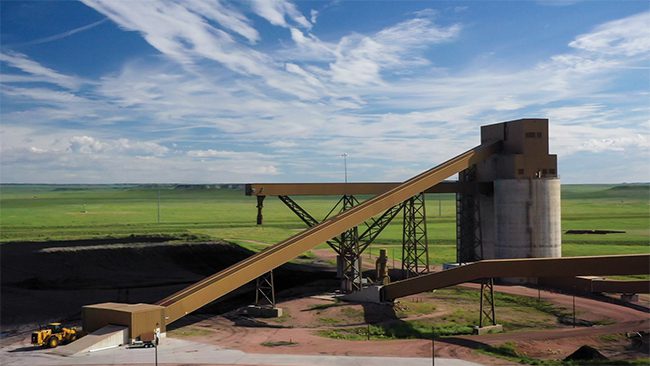 |
3. Powder River Basin coal, which has a subbituminous ranking, presents unique challenges compared to other coal rankings, which makes proper stockpile management very important. Courtesy: Platte River |
Yet, some small amount of dust is inevitable at a coal plant, which is why housekeeping is so important. “We take an extra 24 hours during a major outage to bag up all the electrical systems—it creates huge problems for our I&C team—and we firehose down the entire inside of the building just to get rid of all that coal dust that you just can’t get to otherwise. Big investment, but totally worth it,” said Michie. The station also has a standard housekeeping policy to conduct weekly washdowns of the tripper gallery, coal silos, conveyors, and RCD. “It’s thousands of hours a year that get invested just in housekeeping,” he said.
A Magical Site (and Sight)
“One of the things about Rawhide is: it has some element of magic,” said Brodie Griffin, the plant’s technical services manager. Griffin was referring to the look of the facility and its majestic location. He said the first time he drove across the reservoir dam road approaching the facility, he knew he wanted to work there. Not only is the plant picturesque, but off to the southwest, there are views of Rocky Mountain National Park and Longs Peak, which, at an elevation of 14,259 feet, towers above all other summits in the park. “And, you know, Colorado has 300-plus days of sunshine, so I was pretty much sold before I even stepped foot inside the facility,” said Griffin.
The sentiment seems to be widespread among Rawhide workers (Figure 4), as at least a few got emotionally choked up talking about the pride they felt in the plant receiving the award. “We all completely and absolutely adore that facility, and we really want what’s best for it,” said Griffin. “Our commitment to maintaining the assets, and then our commitment to improving those assets over time, that’s really contributing to our success,” he said.
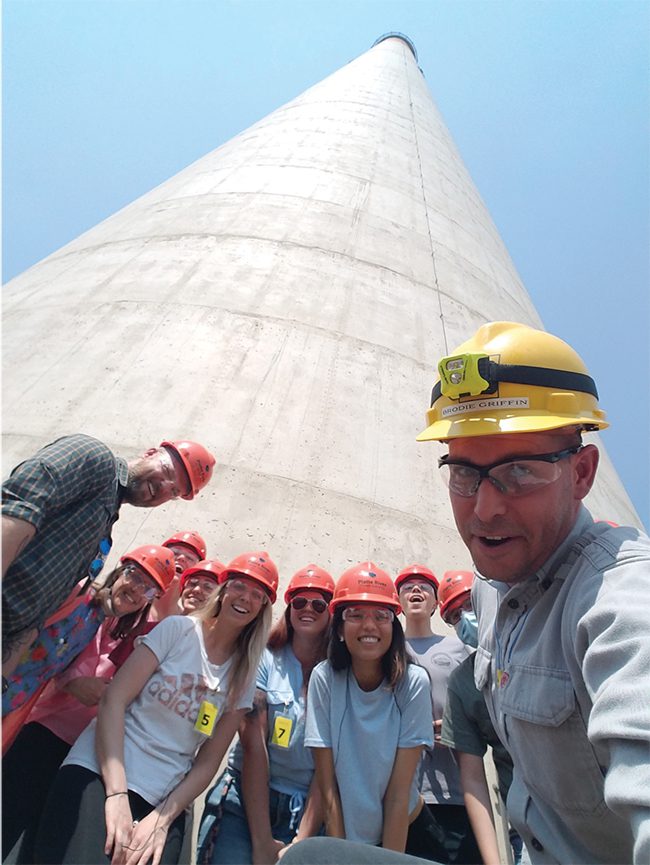 |
4. Rawhide workers take pride in ownership of the plant, which comes across whenever they talk about the facility, such as during this tour led by Technical Services Manager Brodie Griffin (on the right). Courtesy: Platte River |
As Hunter noted at the start, Rawhide’s not perfect, but that’s OK. “It’s not about being perfect. It’s about doing good stuff with great people,” Bob Taylor, an executive committee member and CUG secretary, said. Rawhide’s got that aspect covered. Congratulations Platte River, and especially the team at Rawhide Unit 1. Your group is obviously deserving of the CUG’s most prestigious award. Well done!
—Aaron Larson is POWER’s executive editor.
The post A Long Time Coming: Rawhide Unit 1 Is Coal Users’ Group Plant of the Year appeared first on POWER Magazine.